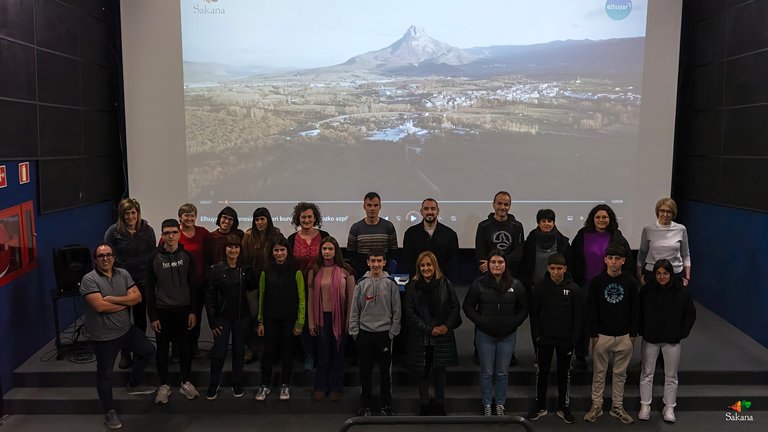Introducing the STEAM diagnosis of Sakana youth
The results of the recent STEAM diagnosis of the young population in the region show that the interest of youth in working in these areas is low

Joseba Aldasoro Galán, Elhuyar STEAM Education Technician, has released the “STEAM Diagnosis of Sakana Youth” in the presentation ceremony held at the Casa de Cultura Iortia de Altsasu. The technician of the Sakana Development Agency, Odei Arrangi Aizpitarte, has also been present.
It has been carried out with the objective of knowing the self-perception of young people between the ages of 14 and 16 around the STEM areas. In addition, the differences between boys and girls and their knowledge of the industry of the region have been analyzed. The questionnaire was prepared by students between 14 and 16 years of age from the Ikastola Andra Mari of Etxarri Aranatz and from the IES Altsasu of Altsasu, Ikastola Iñigo Aritza and the Korazonistak center.
The main conclusions of the results analysis are as follows:
- We can say that traditional gender stereotypes have an impact on the interest of young people in various issues. Thus, the topic that most interested girls is gender equality, followed by a similar level of interest in topics related to health, social issues, food and sport. On the contrary, sport, followed by food, social issues and science and technology, with the same level of interest, is the most important issue for children.
- The degree of interest in subjects is, in general, low. Girls are more interested in Biology (5.7) and show a similar interest in History (5.6), Art (5.3) and Chemistry (5.2), while boys are the subjects most interested in Technology (6.5) and History (6.1), showing a similar interest in the following subjects: Physics (5.5) Computers (5.5) and Mathematics (5.5). Thus, STEM subjects are among the subjects that best value young people, but technology and informatics are not mentioned among the subjects that most value girls.
- As for working in the STEM in the future, girls and boys perceive a very different level of competence: 28.4% of girls and 56.3% of boys consider themselves able to work in this sector. The difference is also evident from the interest they have shown in working on STEM in the future: 22.1% of girls and 39.6% of boys say they would like to work on STEM in the future.
- The interest in certain subjects and working on STEM in the future is closely related to the self-perception of the ability of these subjects to learn and act on STEM in the future.
- It's not the same view that girls and boys have about the way of life for STEM professionals. Boys value the way of life of STEM professionals slightly better than girls (6.5 and 5.7 respectively).
- Young people believe that professional STEM is wise people, workers, entrepreneurs, smart and kind. Some of these features are common adjectives for describing good students, and these stereotyped images of STEM professionals drive many young people away from studying and working in these areas.
- As with the interest shown by young people in some topics, gender stereotypes influence the choice of future professions. Girls have mainly selected professions related to health and social sciences: Teacher, Child Educator, Doctor, Psychologist, Art, Sport… The boys have also selected professions related to technology and sport among which they are most interested: Engineer, Professor, Physiotherapist, Sport…
- About a quarter of the youth say they are unaware of the activity carried out in Sakana, while the remaining 75% are quite clear about the work carried out in the region, as it is related to industry and metallurgy.
- There is an obvious difference between the connotation of words that girls and boys have used to express what suggests them to work in the future in the scientific-technological industry of Sakana or in similar work centers. The girls have expressed more words of negative connotation and the boys have better valued their future idea of working in STEM positions in the region.
- The approach to the working conditions of women and men engaged in science and technology is very different between boys and girls. 46.3% of girls consider that women and men working in STEM work in different working conditions, while 13.5% of boys consider that women and men working in science and technology have different working conditions.
- Comparing the global perspective with that of Sakana, girls have a much more optimistic view of gender equality in the science and technology companies of the region. 32.6% of the girls consider that in Sakana they work in different conditions women and men working in the field of STEM.
- About 40 per cent of young people believe that the benefits and damage to society of scientific research and technological inventions are balanced. There is therefore much work to be done for responsible research and innovation, for an active community with STEM and a more critical society.
All the results of the questionnaire have been collected in this report and video.
Disseminating the map of STEAM diagnostics in the Basque Country
The STEAM Diagnosis of Sakana's Youth has been the tenth study by Elhuyar, the first in Navarra. In 2018, a diagnosis was made among the young people of Debabarrena; in 2020, in Tolosaldea, Bilbao and Txorierri; in 2021, in Debagoiena, Nerbioi-Ibaizabal and Llodio; in 2022, in the region of Goierri; and in 2023, in Donostialdea. So, little by little, we will be completing the map of Euskal Herria.
Buletina
Bidali zure helbide elektronikoa eta jaso asteroko buletina zure sarrera-ontzian











